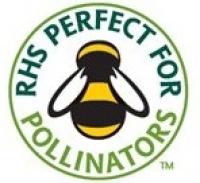Get your Garden Buzzing
 The RHS Perfect for Pollinators Logo
The RHS Perfect for Pollinators LogoThe 'RHS Perfect for Pollinators' label was developed when writer and broadcaster Sarah Raven approached the charity with the innovative idea of flagging up to gardeners plants most suitable for pollinators. The RHS had been working on a research project looking at plants for bugs and was excited by Sarah's idea that a label might get the public and trade more involved.
"Gardens are vital havens for pollinators because they tend to include a much great diversity of pollen and nectar sources available over a longer period than commercially managed agricultural land," says Roger Williams, Head of Science RHS. "As the UK's leading gardening charity this is the sort of initiative we should be involved in to help gardeners be more environmentally friendly. The list and the logo, we hope, will be a practical way to help gardeners really focus in on plants that are best for pollinating insects. We are really pleased to have the support of the Horticultural Trades Association and a real interest from garden centres across the country."
Over the last 50 years a decline in many groups of insects has been noticed. These include some of the common butterflies, moths, hoverflies and bees. The reason for this is complex, but part of the problem may be the reduction in the abundance of wild flowers in the countryside. Gardens with their variety of flowers are increasingly being seen as an important habitat where insects can find sources of nectar and pollen.
"The days of punnets of strawberries costing £50 is fast upon us," says Sarah Raven. "Without insects busying themselves on our behalf pollinating fruit and vegetables, a healthy diet of 'five a day' will soon be gone."
The RHS advises that there are a number of things gardeners can do to help insects. They suggest:
- Gardeners should consult the RHS Perfect for Pollinator list when selecting plants
- Look out for the RHS Perfect for Pollinator logo in garden centres and nurseries
- Avoid plants with double or multi-petal flowers
- Aim to have plants in flower from early spring to late autumn
- Think about using British wild flowers as additions to planting schemes
- Observe the plants in your garden and plant more of those that attract insects
For more information see: RHS Perfect for Pollinator list
Article posted on 05 Jun 2011.
